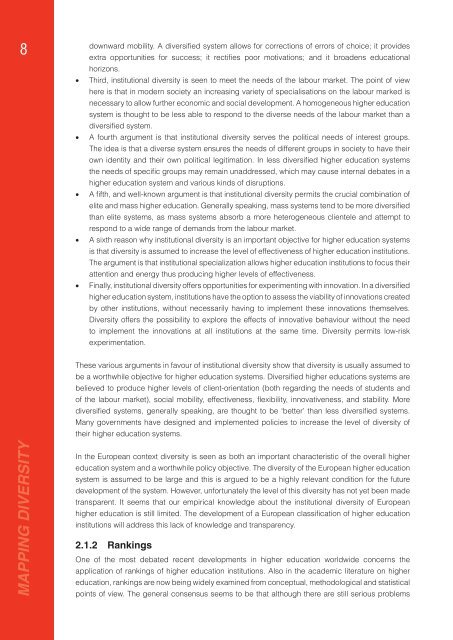Mapping Diversity: Developing a European Classification of ... - U-Map
Mapping Diversity: Developing a European Classification of ... - U-Map
Mapping Diversity: Developing a European Classification of ... - U-Map
You also want an ePaper? Increase the reach of your titles
YUMPU automatically turns print PDFs into web optimized ePapers that Google loves.
downward mobility. A diversifi ed system allows for corrections <strong>of</strong> errors <strong>of</strong> choice; it provides<br />
8<br />
extra opportunities for success; it rectifi es poor motivations; and it broadens educational<br />
horizons.<br />
• Third, institutional diversity is seen to meet the needs <strong>of</strong> the labour market. The point <strong>of</strong> view<br />
here is that in modern society an increasing variety <strong>of</strong> specialisations on the labour marked is<br />
necessary to allow further economic and social development. A homogeneous higher education<br />
system is thought to be less able to respond to the diverse needs <strong>of</strong> the labour market than a<br />
diversifi ed system.<br />
• A fourth argument is that institutional diversity serves the political needs <strong>of</strong> interest groups.<br />
The idea is that a diverse system ensures the needs <strong>of</strong> different groups in society to have their<br />
own identity and their own political legitimation. In less diversifi ed higher education systems<br />
the needs <strong>of</strong> specifi c groups may remain unaddressed, which may cause internal debates in a<br />
higher education system and various kinds <strong>of</strong> disruptions.<br />
• A fi fth, and well-known argument is that institutional diversity permits the crucial combination <strong>of</strong><br />
elite and mass higher education. Generally speaking, mass systems tend to be more diversifi ed<br />
than elite systems, as mass systems absorb a more heterogeneous clientele and attempt to<br />
respond to a wide range <strong>of</strong> demands from the labour market.<br />
• A sixth reason why institutional diversity is an important objective for higher education systems<br />
is that diversity is assumed to increase the level <strong>of</strong> effectiveness <strong>of</strong> higher education institutions.<br />
The argument is that institutional specialization allows higher education institutions to focus their<br />
attention and energy thus producing higher levels <strong>of</strong> effectiveness.<br />
• Finally, institutional diversity <strong>of</strong>fers opportunities for experimenting with innovation. In a diversifi ed<br />
higher education system, institutions have the option to assess the viability <strong>of</strong> innovations created<br />
by other institutions, without necessarily having to implement these innovations themselves.<br />
<strong>Diversity</strong> <strong>of</strong>fers the possibility to explore the effects <strong>of</strong> innovative behaviour without the need<br />
to implement the innovations at all institutions at the same time. <strong>Diversity</strong> permits low-risk<br />
experimentation.<br />
These various arguments in favour <strong>of</strong> institutional diversity show that diversity is usually assumed to<br />
be a worthwhile objective for higher education systems. Diversifi ed higher educations systems are<br />
believed to produce higher levels <strong>of</strong> client-orientation (both regarding the needs <strong>of</strong> students and<br />
<strong>of</strong> the labour market), social mobility, effectiveness, fl exibility, innovativeness, and stability. More<br />
diversifi ed systems, generally speaking, are thought to be ‘better’ than less diversifi ed systems.<br />
Many governments have designed and implemented policies to increase the level <strong>of</strong> diversity <strong>of</strong><br />
their higher education systems.<br />
MAPPING DIVERSITY<br />
In the <strong>European</strong> context diversity is seen as both an important characteristic <strong>of</strong> the overall higher<br />
education system and a worthwhile policy objective. The diversity <strong>of</strong> the <strong>European</strong> higher education<br />
system is assumed to be large and this is argued to be a highly relevant condition for the future<br />
development <strong>of</strong> the system. However, unfortunately the level <strong>of</strong> this diversity has not yet been made<br />
transparent. It seems that our empirical knowledge about the institutional diversity <strong>of</strong> <strong>European</strong><br />
higher education is still limited. The development <strong>of</strong> a <strong>European</strong> classifi cation <strong>of</strong> higher education<br />
institutions will address this lack <strong>of</strong> knowledge and transparency.<br />
2.1.2 Rankings<br />
One <strong>of</strong> the most debated recent developments in higher education worldwide concerns the<br />
application <strong>of</strong> rankings <strong>of</strong> higher education institutions. Also in the academic literature on higher<br />
education, rankings are now being widely examined from conceptual, methodological and statistical<br />
points <strong>of</strong> view. The general consensus seems to be that although there are still serious problems

















